
Last time, we took a look at the characters available to the League of Assassins and organized them into a recruitment plan. Today we will explore the options for non-character cards and seek out the best options to complement the natural plan created by our characters.
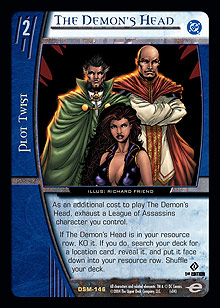 Moving to the non-character cards, my conservative approach to needs explaining. The Demon’s Head is a tool that presents a number of subtle options. The most popular function of this card seems to be oriented toward a toolbox approach.* The League of Assassins incorporates a number of relevant generic locations into its own unique selection.** However, a few words of warning should be given on the philosophy of the toolbox deck. It should not be forgotten that a toolbox, although committed to small numbers of specific cards, still demands a significant aggregate to take shape. This is important because, while multiples of a plot twist may provide cumulative benefits, the features of a toolbox are independent of one another and are not greater than the sum of their parts. Their strength is not in numbers; it is in the capacity of a single card to win the game that justifies the inclusion of all the other cards. While that card will vary from matchup to matchup, this is an important lesson. It follows, then, that a toolbox is not only dependent on easy access to the tools, but also on having tools that are always able to do the job. The chosen tool carries the deck space of all of the useless tools in its designated matchup.
Moving to the non-character cards, my conservative approach to needs explaining. The Demon’s Head is a tool that presents a number of subtle options. The most popular function of this card seems to be oriented toward a toolbox approach.* The League of Assassins incorporates a number of relevant generic locations into its own unique selection.** However, a few words of warning should be given on the philosophy of the toolbox deck. It should not be forgotten that a toolbox, although committed to small numbers of specific cards, still demands a significant aggregate to take shape. This is important because, while multiples of a plot twist may provide cumulative benefits, the features of a toolbox are independent of one another and are not greater than the sum of their parts. Their strength is not in numbers; it is in the capacity of a single card to win the game that justifies the inclusion of all the other cards. While that card will vary from matchup to matchup, this is an important lesson. It follows, then, that a toolbox is not only dependent on easy access to the tools, but also on having tools that are always able to do the job. The chosen tool carries the deck space of all of the useless tools in its designated matchup.
That The Demon’s Head is an engine powerful enough to provide easy and consistent access to the tools is not in question. The question is whether or not the tools available are powerful enough to justify carrying the other tools around, too. Before we can answer that question, we need to consider our wider and more abstract plan. To even consider establishing the toolbox, we first have to ensure that our recruitment plan is secure, and then ensure that we are able to compete in combat. We have a recruitment plan that begins on turn 2 and wants to hit drops until as far as turn 8. This is very demanding. That our backup options on the curve are so much less appealing than our primary options signals that we want access to about two search effects per game to maximize our chances of optimal recruitment. Thus, at this stage, it would be wise to think of The Demon’s Head as Mountain Stronghold numbers five through eight. Some may think that a waste of such a flexible card, but this deck isn’t about the power of one card, it is about enhancing and imposing the strength of the League of Assassins characters on their opposition, and until that plan is secure, we have to do everything we can to cement it.
There are two exceptions we should entertain. Firstly, cards that we know will automatically win a matchup without us necessarily landing the necessary recruitment plan. Only Latverian Embassy (against combo decks or decks relying on large amounts of team-ups) fits that bill. Some may point to Lazarus Pit, but the majority of decks and plans that Pit is useful against require us to hit our drops to win, anyway. Thus, I could entertain running the full complement of Lazarus Pits if it really were that good, but it is a very narrow plan. If we were to only run one, we would have to rely on The Demon’s Head to fetch it, and we have shown that in the matchups where that is good, Mountain Stronghold is still our first priority.
Pit of Madness is just not that good at all. It is a one-shot wonder, and the lack of flight or range in the affiliation means that you can’t often draw your opponent into an attack that will warrant its use. Avalon Space Station doesn’t really do enough, either. It is useful at certain times, but our characters are not really in need of recursion. Flying Fortress is a solid card, but it is difficult to see it being better than Flying Kick; we don’t want to draw Flying Fortress in multiples. Note the problems of drawing multiple locations (barring the non-unique options).***
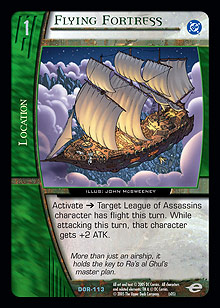 However, there is a second exception to our general plan. There will often be games where our redundant plan will secure the curve for us early, so extras of Mountain Stronghold will be merely for power-ups. A second exception should be made for a single extra location that can be fetched to ensure that the power of The Demon’s Head is not totally boxed. Flying Fortress narrowly beats Lazarus Pit for this slot. Much of this has to do with the fact that its ATK bonus and formation breaking potential more readily complement our mid-game plan than the reactive Lazarus Pit.
However, there is a second exception to our general plan. There will often be games where our redundant plan will secure the curve for us early, so extras of Mountain Stronghold will be merely for power-ups. A second exception should be made for a single extra location that can be fetched to ensure that the power of The Demon’s Head is not totally boxed. Flying Fortress narrowly beats Lazarus Pit for this slot. Much of this has to do with the fact that its ATK bonus and formation breaking potential more readily complement our mid-game plan than the reactive Lazarus Pit.
Before considering generic options, we need to address the affiliated options for non-character cards. A card that definitely warrants inclusion is Tower of Babel. Tower of Babel provides a uniquely powerful effect. A surprise beneficiary of the banning of Overload (whereas Not So Fast became a whole lot less appealing), Tower of Babel effectively unaffiliates the opposing team for its attack step. This capacity cripples faster decks that often rely on team attacking, and it virtually negates the powerful team-stamped effects your opponent is likely to run. In the current metagame, Tower of Babel is a game winning card against such powerful archetypes as Teen Titans and TNB. It can be sluggish against Curve-based strategies and may find little use against combo decks (generally, though, it is powerful at certain junctures). These disadvantages are minimal, however, as it will single-handedly nerf the plans of the most consistently powerful weenie decks. This will give us time to establish our mid-game presence and will potentially disrupt any chances of comebacks when drawn in multiples. A full complement seems in order.
We can quickly dismiss the The Shrike and Wheel of Plagues because we will never be in a position to under-drop for the turn to play equipment. Neither of those cards are a compelling reason to change our minds. Remake the World seems terrible in general, but is probably even more so here considering that we are unlikely to be relying on large numbers of locations (which we have seen is a dangerous plan, anyway). Clench Virus is an interesting card, but outside of the aforementioned Wheel of Plagues, which is costly, there isn’t much hope for as narrow a plan as this card dictates. Shadows of the Past seems like a good card, echoing Tower of Babel, but it operates too narrowly and counteracts one of our most powerful weapons, Ra’s Al Ghul, Eternal Nemesis.
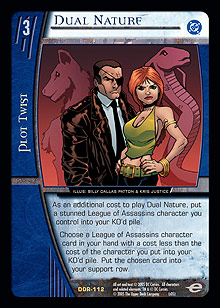 The only real standout, besides Tower of Babel, is Dual Nature. Unfortunately, I don’t think it can make the cut here, although I do not doubt its latent power. The power of Dual Nature is likely a reason for the alarming lack of range available to this affiliation. Taking that on board, the problem I have with Dual Nature is not its power, but the application of that power. Although Dual Nature even gets around uniqueness, it requires a lot. Not only must you have a game state where it is advantageous to remove a character from play to be replaced with a smaller character, you also require a relevant character in hand. Without an archetype built specifically around this card, it is merely a glorified and often random recovery trick. Unfortunately for Dual Nature, we cannot spare the resources to follow through on its potential. Our character search is already strong, but necessarily so, and to divert resources from that to follow the often fickle promises of this card is too much. If we are unable to ensure a better plan, we may come back to it, but it would be a last resort at this stage.
The only real standout, besides Tower of Babel, is Dual Nature. Unfortunately, I don’t think it can make the cut here, although I do not doubt its latent power. The power of Dual Nature is likely a reason for the alarming lack of range available to this affiliation. Taking that on board, the problem I have with Dual Nature is not its power, but the application of that power. Although Dual Nature even gets around uniqueness, it requires a lot. Not only must you have a game state where it is advantageous to remove a character from play to be replaced with a smaller character, you also require a relevant character in hand. Without an archetype built specifically around this card, it is merely a glorified and often random recovery trick. Unfortunately for Dual Nature, we cannot spare the resources to follow through on its potential. Our character search is already strong, but necessarily so, and to divert resources from that to follow the often fickle promises of this card is too much. If we are unable to ensure a better plan, we may come back to it, but it would be a last resort at this stage.
Having run through the affiliation, we have the following template:
4 Bronze Tiger, Benjamin Turner
1 Assassin Initiate
2 Talia, Beloved Daughter
4 Ubu, Ra’s Al Ghul’s Bodyguard
1 Hook, Hired Killer
4 Ra’s Al Ghul, Eternal Nemesis
1 Merlyn, Deadly Archer
4 Bane, Ubu
1 Whisper A’Daire, Cold-Blooded Manipulator
3 Sensei, Martial Arts Master
1 Ra’s Al Ghul, Master Swordsman
2 Dr Ebenezer Darrk, Original Leader of the League
1 Lady Shiva, Master Assassin
1 Ra’s Al Ghul, The Demon’s Head
4 Mountain Stronghold
1 Latverian Embassy
1 Flying Fortress
4 The Demon’s Head
4 Tower of Babel
We must remember that the above listing of 44 cards is important for what it does not include as much as for what it does. We have sixteen cards remaining with which to consolidate our plan and round out the deck.
We need to play to our strengths. We have decided that this deck is a combat orientated deck. What does this mean? The strengths of the deck are undeniably drawn from the incredible KO potential of Ra’s Al Ghul, Eternal Nemesis and Bane, Ubu. We have already seen how a successful recruitment plan of Bronze Tiger, Benjamin Turner and Ubu, Ra’s Al Ghul’s Bodyguard will more often than not allow us to bring our heavy hitters into play unmolested. We have also seen how they will provide valuable support for breaking formations and removing less important characters so that our mid-game potential can be realized. However, we are going to need additional support from plot twists if we are to ensure the redundancy of our plan.
Ra’s Al Ghul, Eternal Nemesis only has an average ATK for his drop, so we will need pumps to bring his effect online. This will also vicariously help Bane, Ubu, who likes to pick on smaller characters, as our smaller characters will be able to attack larger characters with adequate pumps. To this effect, you cannot surpass the marquee card of Vs. System—Savage Beatdown. An extra 5 ATK takes Ra’s Al Ghul, Eternal Nemesis far up the character slope and will ensure that other characters are successful in their attacks. For any deck trying to win combat, Savage Beatdown is a must-have at the maximum number of copies.
However, between Savage Beatdown and the erstwhile (at least in this deck) Flying Fortress, we need more pumps. Our most common plan revolves around mid-game dominance and not only matching the DEF of our opponents, but also being able to deal breakthrough if necessary. There are many more options here, so we should take time to consider what our deck really needs before moving on. The League of Assassins is burdened by a miserable paucity in flight and range. This makes it difficult to break formations to establish breakthrough, and it also makes it hard to establish the mismatches we need to hammer home our advantages with the KO plan. We need to add some more flexibility in this regard and not merely play for brute force, at least if we want to make our initiatives count. The stress on initiative is important. We are unlikely to make many inroads on our non-initiative turns, as we are going to need to make many conservative formations to prevent damage when defending. For this reason, Mega-Blast, which is already a narrow card, should be ignored.**** Flight is extremely important, so Flying Kick is definitely the best card if we consider flight exclusively.
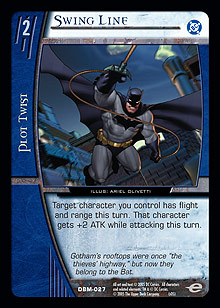 However good Flying Kick is, I think there is a better option. Swing Line is an underappreciated card that has a lot going for it. Swing Line packs just enough of an ATK punch to be relevant (power-ups are fatal). But most importantly, it gives you flight or range for any character. This allows you to capitalize on your opponent’s formations and attacks in a more flexible way then either Flying Kick or Mega-Blast does. With Ra’s Al Ghul, Eternal Nemesis, you can casually position him at the back, perhaps behind Ubu, Ra’s Al Ghul’s Bodyguard, and counterattack brutally when your opponent leaves him alone. On initiative, you can send anyone over the top to break formations so that Ra’s Al Ghul, Eternal Nemesis can deal breakthrough, or so that Bane, Ubu can hit the weak link. Where Savage Beatdown provides compulsory force, Swing Line offers redundancy in another combat modifier that also enhances the potential of the basic plan by giving it much-needed flexibility. Between Swing Line, Savage Beatdown, and Flying Fortress, we have a robust and flexible combat suite.
However good Flying Kick is, I think there is a better option. Swing Line is an underappreciated card that has a lot going for it. Swing Line packs just enough of an ATK punch to be relevant (power-ups are fatal). But most importantly, it gives you flight or range for any character. This allows you to capitalize on your opponent’s formations and attacks in a more flexible way then either Flying Kick or Mega-Blast does. With Ra’s Al Ghul, Eternal Nemesis, you can casually position him at the back, perhaps behind Ubu, Ra’s Al Ghul’s Bodyguard, and counterattack brutally when your opponent leaves him alone. On initiative, you can send anyone over the top to break formations so that Ra’s Al Ghul, Eternal Nemesis can deal breakthrough, or so that Bane, Ubu can hit the weak link. Where Savage Beatdown provides compulsory force, Swing Line offers redundancy in another combat modifier that also enhances the potential of the basic plan by giving it much-needed flexibility. Between Swing Line, Savage Beatdown, and Flying Fortress, we have a robust and flexible combat suite.
Having allotted space to the necessary support of our offense, we next need to look to our defenses to ensure that we are not blown away by damage in the early game, and to ensure that our vital early and mid-game characters survive to wreak havoc. The most obvious addition would be Acrobatic Dodge, but this is unwise for the following reasons. While it is not significant that the character inspired to Acrobatic Dodgeimmediately stun the character attacking it, the current Golden Age metagame demands that Acrobatic Dodge grant more of a benefit than mere survival. This is because the ATK pumps available in this format are much greater than the DEF pumps available, and thus, space devoted to DEF pumps needs to more often than not ensure sufficient DEF to defeat the opponent’s ATK. Otherwise, it is just preventing damage. As ATK pumps generally double as endurance loss when played on direct attackers, players can afford to play more of them. For Acrobatic Dodge to be worthwhile in this deck, we need to ensure some level of redundancy for it, which I don’t think we can do. A case can be argued that Tower of Babel turns Acrobatic Dodge into a powerhouse, but the lack of flight and range in the affiliation means that we’d need to make potentially risky formations to get the most out of that combination of cards. I think there is a better and more flexible defensive option available, even if it is more costly.
Entangle has seen play in various Pro Circuit decks, but has yet to see mainstream appreciation. For decks that want to play for the largest character on the board, that time has come. Entangle complements our early game defense admirably, thwarting the early advances of teams like The Brotherhood and Teen Titans and giving us a much needed level of redundancy in our plan against weenie strategies.***** Against non-combat decks, it can provide a must-negate effect against cards like Shimmer. Even against combat decks, it can allow us to protect our vital characters for our own initiative. We are likely to have a few loose characters in hand that, unless pitched to Mountain Stronghold, are useless for anything other than powering up. Being able to expend those characters on an effect as powerful as Entangle can be is well worth it, and I think the full complement is necessary to give us game against some of the weenie decks that can ruin our plans.
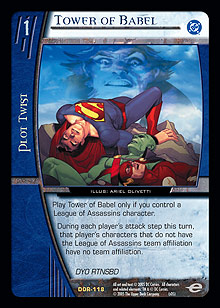 That gives us four slots to work with, and we have a number of options to consider. We have tied up most of our loose ends. Our character base with effectively eight potential copies of Mountain Stronghold is secure, and any ideas such as Weapon of Choice seem superfluous. Our combat modifiers seem strong enough, though we could always do with more. We can return to this if we don’t feel like there are any better options, but for the time being, we seem to have what we need. Our early game defenses are redundant enough to be consistent, and it is important that we don’t play too many reactive cards, as we are essentially playing a proactive deck. Entangle and Tower of Babel are not strategies unto themselves, but rather are there to bring on the main plan.
That gives us four slots to work with, and we have a number of options to consider. We have tied up most of our loose ends. Our character base with effectively eight potential copies of Mountain Stronghold is secure, and any ideas such as Weapon of Choice seem superfluous. Our combat modifiers seem strong enough, though we could always do with more. We can return to this if we don’t feel like there are any better options, but for the time being, we seem to have what we need. Our early game defenses are redundant enough to be consistent, and it is important that we don’t play too many reactive cards, as we are essentially playing a proactive deck. Entangle and Tower of Babel are not strategies unto themselves, but rather are there to bring on the main plan.
What is that main plan? Simply, it is to achieve a dominant board position through the stunning and knocking out of our opponent’s most dangerous early game characters. This will allow us not only to gain power through numbers in the late game, it will also protect our high-end curve, which although reasonable, is nothing better than average and needs to fight unfairly against smaller opponents to secure the win. For that reason, Finishing Move takes the remaining slots. It ensures that our KO plan will come into effect and it allows us to remove problem characters more consistently in the early game, thus enabling us to clear a path for our mid-game to impose itself. Finishing Move operates well with the 2-drop protected by Ubu, Ra’s Al Ghul’s Bodyguard and can often ice a game where Ra’s Al Ghul, Eternal Nemesis and Bane, Ubu have done the early ground work.
This leaves us with the following list:
4 Bronze Tiger, Benjamin Turner
1 Assassin Initiative
2 Talia, Beloved Daughter
4 Ubu, Ra’s Al Ghul’s Bodyguard
1 Hook, Hired Killer
4 Ra’s Al Ghul, Eternal Nemesis
1 Merlyn, Deadly Archer
4 Bane, Ubu
1 Whisper A’Daire, Cold-Blooded Manipulator
3 Sensei, Martial Arts Master
1 Ra’s Al Ghul, Master Swordsman
2 Dr. Ebenezer Darrk, Original Leader of the League
1 Lady Shiva, Master Assassin
1 Ra’s Al Ghul, The Demon’s Head
4 Mountain Stronghold
1 Latverian Embassy
1 Flying Fortress
4 The Demon’s Head
4 Tower of Babel
4 Savage Beatdown
4 Swing Line
4 Entangle
4 Finishing Move
This deck wants to mulligan for a 2-drop or a means of establishing a 2-drop. Hands with Mountain Stronghold and a drop somewhere between 2 and 4 are generally okay too, as the redundancy of The Demon’s Head and the recruitment plan will more than provide the answers. Remember that much of the deck’s power plays off of the optimal recruitment curve, and while Bronze Tiger, Benjamin Turner is not always the necessary drop, the next three drops are hardly ever interchangeable. The optimal recruitment plan is your first priority and you must not let anything come in the way of dropping the appropriate characters. In some matchups, you will find that you can play around with this, but being flippant will lose you the game. The deck has been built around the characters, and if you get them in play, the consistency of the deck will give you enough options that your opponents will have to beat you rather than have you simply lose to bad draws.
To sum up, you are playing primarily to maximize your mid-game KO effects. Don’t burn Swing Line early and be careful to get the most out of Entangle and Tower of Babel. Unless you have the whole recruitment plan in your hand, use The Demon’s Head only for Mountain Stronghold . . . unless Latverian Embassy will win you the game.
Good luck and stay tuned for a matchup guide to follow!
* A toolbox, in gaming terms, refers to a plan or set of cards that is essentially reactive, offering a number of generally accessible options from which the player can select the best tool for the game state.
** A quick list would include Mountain Stronghold, Flying Fortress, Pit of Madness, and Lazarus Pit as the most powerful affiliated options; and Avalon Space Station, Psychoville, and Latverian Embassy as worthwhile generic considerations. Metropolis will allow for smooth team-up potential.
*** A plan that relies on large numbers of locations for its non-character allotment, such as the Brotherhood of Assassins, often acts as virtual card disadvantage. This is because, unlike plot twists, locations cannot be played from hand. A red hand is bad (one that’s full of characters), but a greenone is worse.
**** Mega-Blast must target a support row character. This means that a considerable amount of foresight is necessary on the player’s part. Unfortunately, the sort of foresight required is only likely to be available on your own initiatives, diluting much of its potential. You want your pumps to be able to trump your opponent’s DEF tricks and thus be applicable to any character. More importantly, you need to break formations before sending in the heavy artillery. Mega-Blast is not flexible enough for its extra ATK.
***** The redundancy is with Tower of Babel, which excels against small men. Redundancy is always more important against weenie decks (and for weenie decks themselves), which are more likely to give you less cards to bring your plan online, so you need to make each one count.